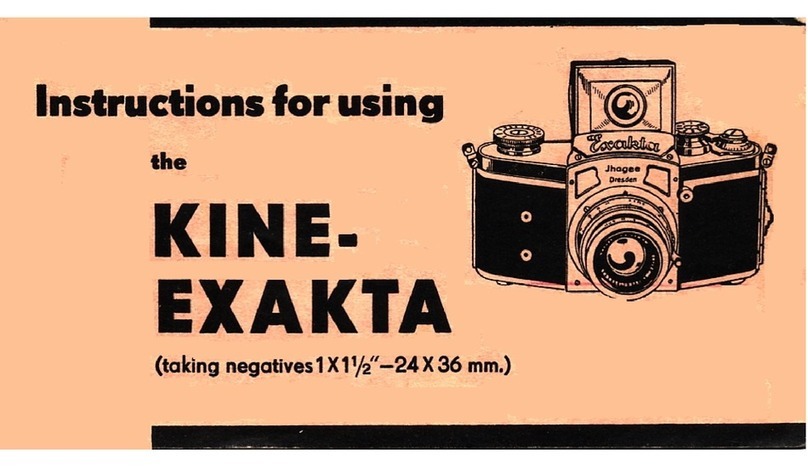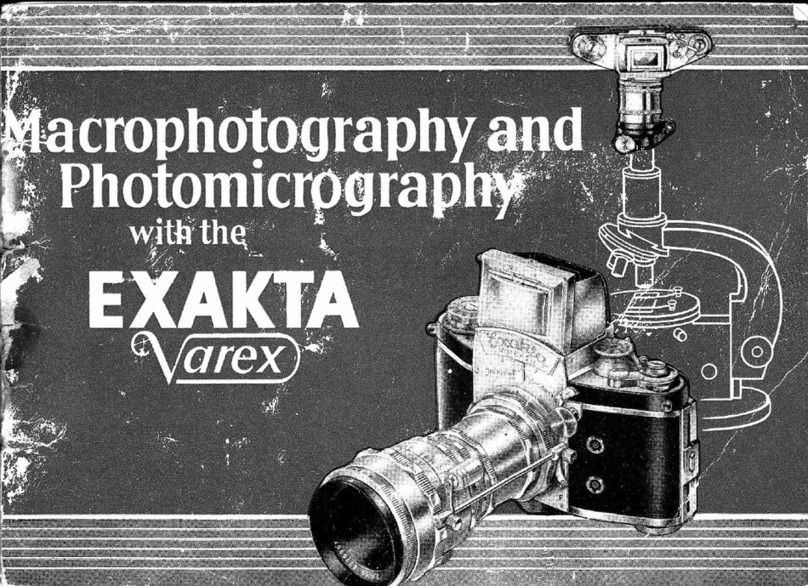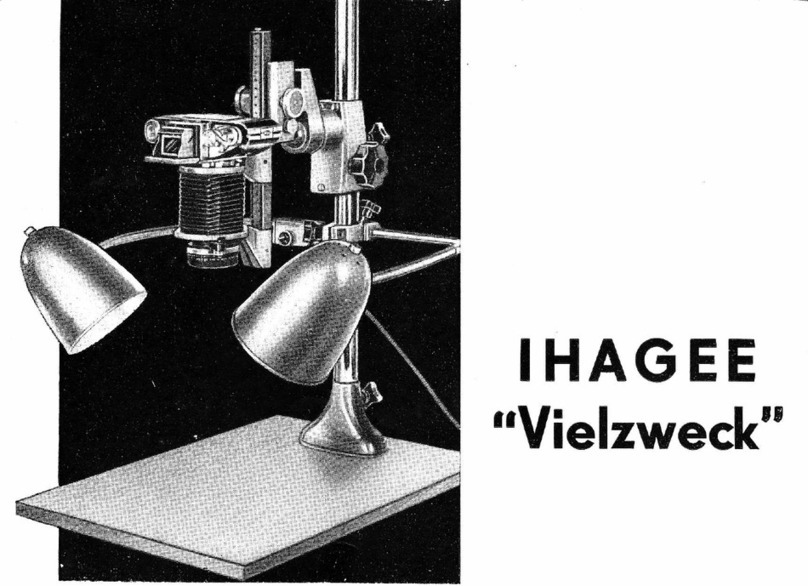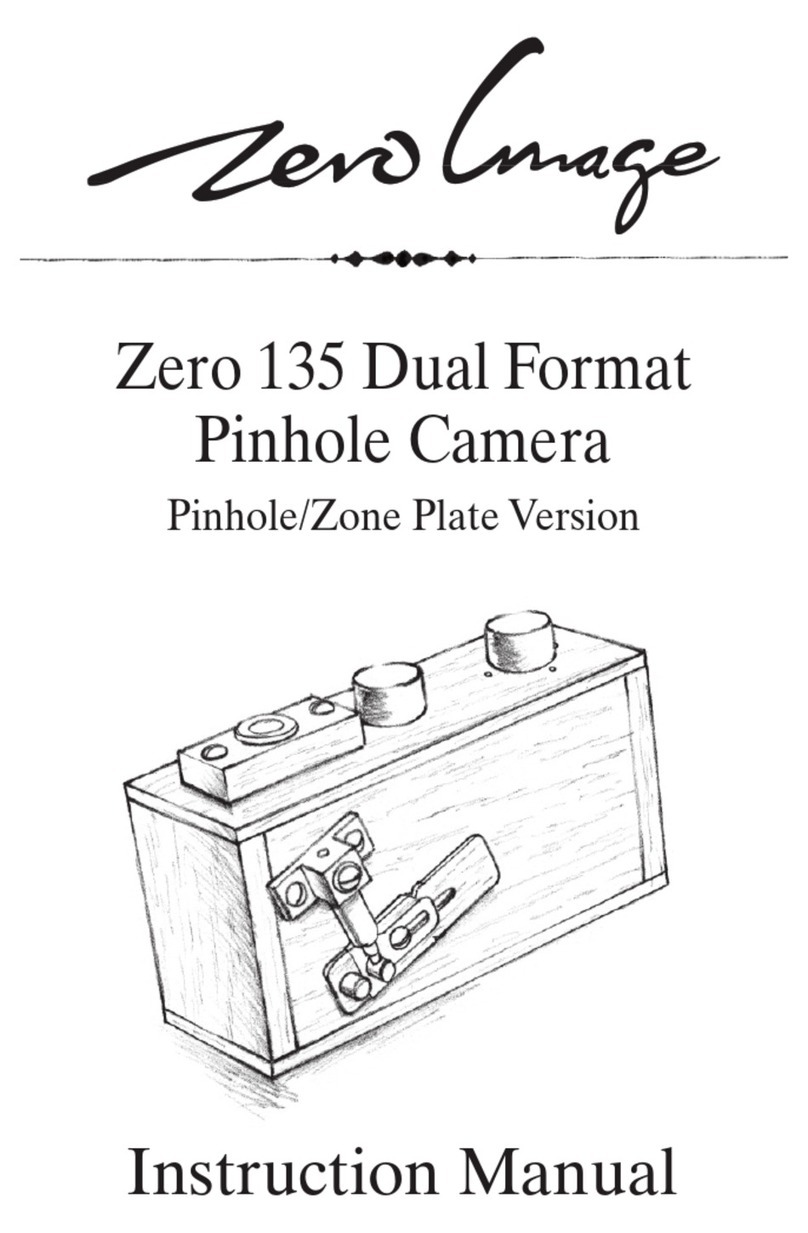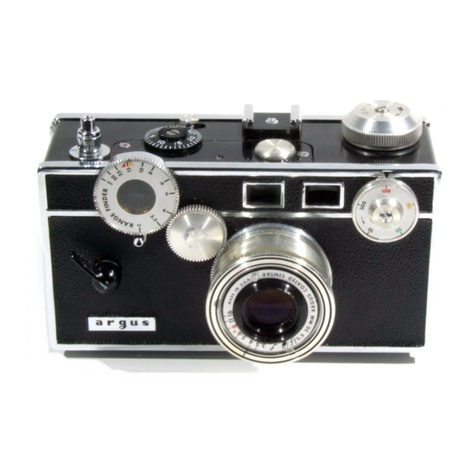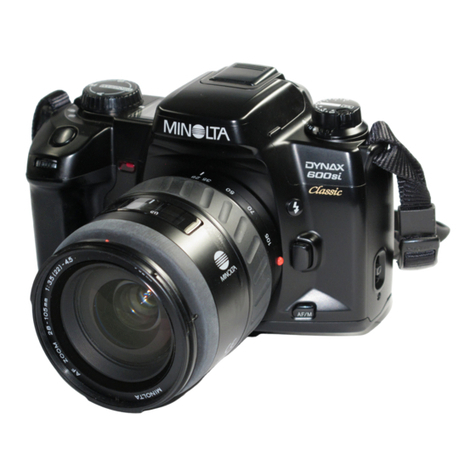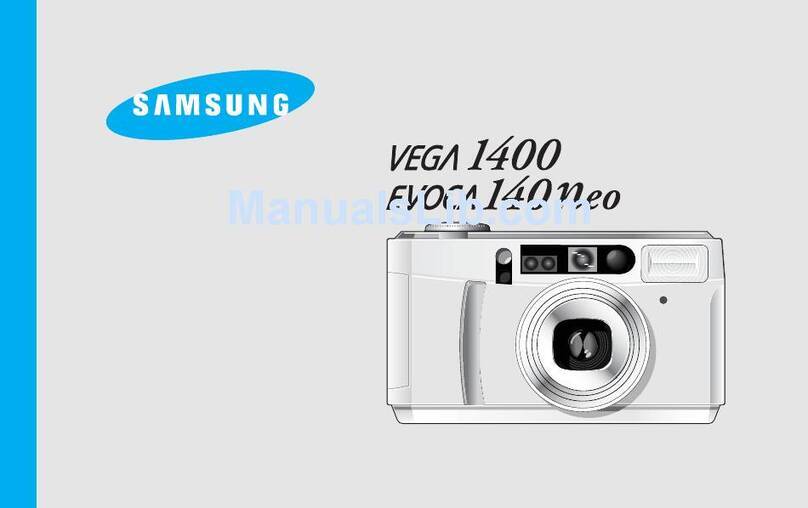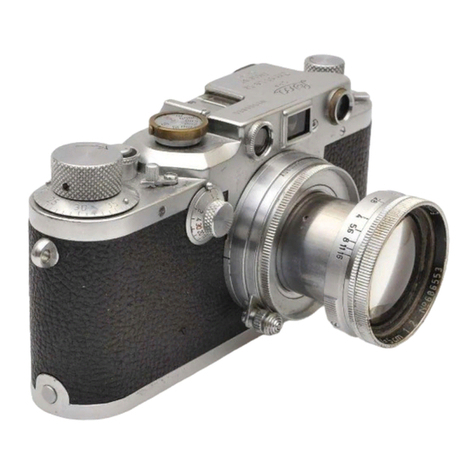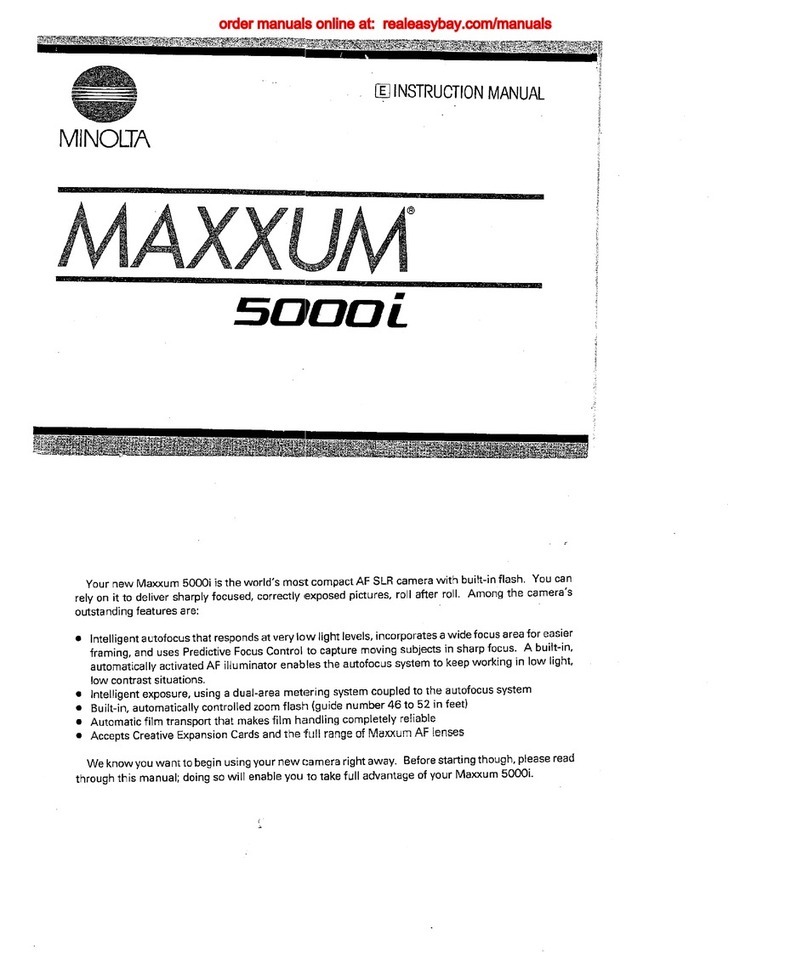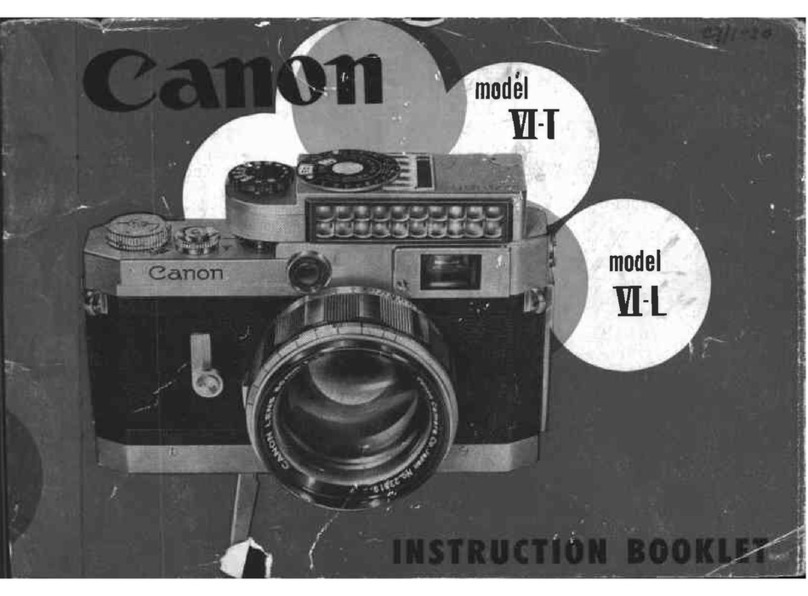Ihagee Vielzweck User manual

IHAGEE
"Vielzweck"

lhogee 'Vielzweck"
The lhogee "Vielzwe&" is bosed on the "Add
On" principle, whereby ihe user of EXAKTA
equipmenl con, occording to requirements ond
budgel, groduolly increose the versoiility of this
equipment, uii lising the mony interdrongeoble
occessories ovoiloble in the EXAKTA ronge.
The "Vielzwed<" con olso be used wiih EXA
models lo und llb; lhere ore, however, o few
limitotions with ihe EXA lo.
The EXAKTA ronge of comeros, provided with
o few bosic occessories, hove proved very
success{ul in mony fields of opplicotion. The
oddition oI the "Vielzweck", however. meets the
most exocting requiremenls of the odvonced
omoteur, professionol phologropher ond scien-
lilic worker.
The object ol this booklet is to summorise ihe
moin opplicolions of the"Vielzwed<". ln oddi-
tion, the equipment con olso be conveniently
orronged to occomplish mony other photo-
grophic losks.
IHAGEE KAMERAWERK AO
80I6 DRESDEN
L_. ,.

The Swing Angle Attochment
(Fies. l...3)
It consists of the swing ongle top (10) ond the
focusing slide (l). The swing ongle top (10) is
pushed onto the slide roil (2) of the focus.
ing slide: For this purpose loosen the locking
lever (ll) by swinging it to the lefr up to the
stop. Push the swing ongle top on to the end
of lhe slide roil (2) (recognizoble by the
lorge scole). Set the lod<in9 screw (3) with the
cut-off port of its heod on o level with the
slide roil (2). With the swing ongle top
pushed on to the slide roil, slightly tighten
the lo*ing screw (3), cqusing lhe round port
of the screw heod lo project o little obove the
slide roil, whidr will preveni lhe swing ongle
lop from slipping off.
With the swing ongle top in use, the scoles on
the slide roil (2) become involid. You ore
Fis, 1
lt

s,
:tl
;4'
,8.
-5
oble to set ihe swing ongle iop ond lock it in
ony desired posilion by simply turning down
the lod<ing lever (1 i)to the right. As shown in
Figs. 1 ond 2 the comero is fostened lo ihe
ongulor piece (14) by meons of ihe fostening
screw (i3). This fosiening screw is designed for
comeros feoturing on English tripod sockel
(1/4") or o Continenlol tripod sod<et (3/6")'
Remember thot the lod<ing-nut (12) hos ro be
screwed in between the ongulor piece (14)
qnd the heod of the fostening screw (13)' As
soon os ihe fostening screw hos been driven
deep enough into ihe tripod socket of the co'
mero, the locking"nut must be screwed ogoinst
the ongulor piece' To move the comero
{rom ihe horizontol to the verticol position, or
vice verso, the ongulor piece (14) is movoble
in boih direciions on pulling out ihe locking
knob (15). This knob clicks in outomoticolly
when ihe ongulor piece (11) hos completed o
900 rototion. For horizontol working the swing
ongle ottochmeni, on to whidr the comero hos
Flg.2

been screwed, is simply set upon o toble. The
swing ongle otlodrmenl will be very use{ul
when connected to o tripod either in horizontol
position, or with the oid of o tihing heod for o
kipod, it con be lostened in o verticol position.
An English or Continentol tripod so&et will be
found ot the bottom oI the sliding blod< (8). The
extension required for the piclure rotio is pro.
duced by inserting boyonet ringi ond tubes. For
criticol focusing lhe swing ongle otiochmenl
offers two possibilities: Either you move the
swing ongle top (10) wilh the comero ottodred
on the slide roil (2) ro ond fro (do not forget
to loosen locking lever (ll) ond retighten it),
or you moke use of the ro& of the focusing
slide ond shift the slide roil with swing ongle
iop ond comero mounted. Shifting the tripod
will be hordly necessory, for the swing ongle
ottochment's wide focusing ollows omple ploy
for vorying the subject disionce. Shorp focusing
is controlled on ihe re{lex imoge of lhe comero.
Moving the slide roil (2) to ond fro is occom.
plished by ociuoting the lwo roc.k.ond-pinion
knobs (4 ond 5). When working with the oppo-
rolus in verticol posilion lhe rod-ond pinion
knob (5) serves for lod<ing ihe. slide roil (2).
preventing ils being pulled down by the weight
of the comero. The rod<.ond-pinion knob (5)
is screwed clockwise light ogoinst lhe sliding
blod< (8) during whidr performonce the oppo-
site knob (4) must be held tight. lf the ro*.
ond-pinion knob (5) is io oct once more os o
locusing knob. it must be turned owoy from the
sliding blo* (8) ond fixed in its endposition
during whidr performonce lhe knob (4) must
ogoin be held tight. Loding screw (6) prevents
the swing ongle top from slipping off the slide
roil (2) while working with the opporotus in
verlicol position. (Hole (7) ond lo&ing knob (9)
serve lo receive the tronsporency copying
equipmenl; pleose see olso poge l3).
It is recommended to use the oulocouple exten.
sion releose (Figs. I ond 2) when using boyonel
rings ond lubes in connection with the fully
outomotic spring or pressure diophrogm me-
dronism of lhe lenses.

i:-;i!,1 Stereo Photogrophy with Swing Angle
Attochment
ln slereo (3 dimensionol) photogrophy you
ore not obsolutely bound lo moke both expo-
sures simultoneously using two lenses or (os in
the cose of ihe Slereo Atlochments of our co-
meros) two prisms. The two stereoscopic pictures
con be token in succession. The comero, in ihis
cose, hos two different stondpoints ond the
distonce between these lwo points is colled
lhe "stereoscopic bose": lhe object must, of
course. be molionless. The stereoscopic effect
is considerobly enhonced by "wide bose" ex-
posures, in whidr ihe distonce belween the two
pictures is not the usuol 6.5 cm - interoculor
distonce -, but where o greoier loterol move-
ment of the comero is possible. The swing ongle
cttochmenl connected to o sturdytripod, permits
moking siereo exposures with o bose of olmosl
50 cm. The focusing slide ('l) is fixed to the
tripod ot q right ongle to the viewing line
Flg, 3
l4l
15

I
(Fig.E). While pulling knob (15), turn the ongu-
lor piece (14) upwords; bringing the plote with
the hole for the fostening screw to the lop,
reody to occept the comero ot o right ongle
to lhe focusing slide lor horizonlol exposures.
The comero is fostened by meons of {ostening
screw (13) ond the lodcing nut (12) is ogoin
screwed in between the heod of the fostening
screw ond lhe ongulor piece (14). The stereo
bose is obtoined either by the swing ongle top
(10) on the slide roil (2) or by oddiiionol
odjustment ol the slide roil (2) irself. by meons
of the rod<.ond.pinion medronism of the focus.
ing slide.
Nos. for ordering
Focusing slide (l) 155.01 U7 '
Swing ongle top (10) 155.03
Swing ongle ottodrment (l + l0) 155.08
Pleose stote whelher lhe comero hos on.Eng.
lishor Contineniol tripod sodcel.

Bellows Attochment
(Fiss, 4 ond 5)
ll consists of the bellows top ottochment (20)
ond the focusing slide (1). The lod<ing levers
(21 ond 25) locoted on comero holder ond lens
holder respectively must be loosened byturning
them counterclockwise up to the stop. Comero
holder ond lens holder hove to be pushed
together so thoi the bellows ore protected.
First ihe lens holder l22l ond then the comerq
holder of the bellows top oilochment (20) ore
pushed on to the toil-end of ihe slide (recog.
nizoble by the lorgesl volues on the scole).
Fis. 1

The loding screw (3) must be sei in sudr o
woy thot the cut-off section of the screw lies
on o level with the upper surfoce of the slide
roil (2). Hoving pushed the holders on, tighten
loding screw (3) cousing the round port of the
screw heod lo project the surfoce of the slide
roi'l, thus preventing on occidenlol slipping off
of the bellows top ofiochment. lt is odvisoble
lo ploce ihe bellows iop ofiodrmenf (20) to.
words the opposite end of the slide roil (2)
ond to lo& the lensholder in this position by
turning lever (24) to the right. lt will be possible
to move lhe comero holder (22) to ond Iro on
the slide roil (2), os required for focusing. The
comero holder con be lod<ed in position by
turning lever (25) to the right. Of course, the
lens holder l22l con olso be moved.
When lostening lhe comero to the comero
holder (21) moke sure thot the red dots on the
two boyonet rings ore exoctly opposiie eodr
other. Then turn the comero clod<wise (in view.
ing direction) until the lod<ing lever clid<s
into the boyonet fitting. The comero is now
reodyfor verticol exposures. lf you intend work"
ing in horizontol position, lurn the comero
bod< ogoin by 900 up lo ihe stop. you ore ot
liberty to use ony slondord or speciol supple-
mentory lens lo fit our single lens reflex come.
ros, with the exception of extreme wid.e-ongle
lenses with o focol length of less rhon 30 m .
Also lenses leoluring very long focol distonces
ore nol very procticoble on the bellows ottodr.
ment. When fixing the lens into the lens holder
(221 the red dots on the boyonet fitiings must
meel. lnsert the lens into lhe boyonet mounf
ond lurn clockwise until loding lever (26)
clids in.
The smollest increose in extension obtoinoble
wilh the oid ol the bellows ottochment is
35 mm, the greotest opproximotely 220 mm.
The 35 mm exiension increose. when using
50 mm stondord lenses, shows on imoge scole
of reproduction of 0.7 ond subjects meosuring
34 mm x 5l mm ore reproduced in full. The
wellknown speciol lens leno T f 2,8/50 mm is
ovoiloble with sunk mount for toking lorger
I
ts-
I
.{
rl
j!
fi
I

subjects with the oid of the bellows ottochment.
It will olso ollow focusing ot longer dtstonces
(up to in{inity). The block {igures on the scole
of the focusing slide (1) signify the increose in
extension in mm for the usuol stondord, short'
or long-focus lenses of our comeros, whereos
the red figures refer to the increose in exlension
when using ihe speciol lens Jeno I f 2'8/50 mm
with sunk mount. This lens con, therefore, cope
with exlension increoses ronging {rom 0 up to
185 mm. The scole volues hold good only with
lens holder (22) in position ogoinst ihe {roni
stop of the slide roil (2). lt is the meosurement
visible ogoinst ihe upright reor surfoce o{ the
comero holder thot counts.
lf the bellows lop ottodlment (20) is to be
removed from the focusing slide (1), it is in oll
coses odvisoble, for ihe soke of preservinq ihe
bellows olter lobsening the levers (21 ond 25),
io push lens holder (22) ond comero holder
(21) together. ond then lo drow them together
from the slide roil (2). lt will be necessory to
sel the locking screw (3) so thot its loterol cut'
off section lies on o level with the upper sur'
foce of the slide roil (2).
For horizonfol working, ihe bellows ottodrmenl
{ostened to the comero con beset on o toble.
The bellows ottodrment con be fixed on o
sturdy tripod either in horizontol position or,
with the oid of o pon ond tilt tripod heod, in
o verticol position. An English ond o Continen'
tol tripod socket will be found ot lhe bottom
of the sliding blo& (8). Moreover,the bellows
ottochment is one of ihe essentiol component
ports of the repro unit (see poge 21).
The necessory increose in extension is obtoined
by drowing out the bellows: Loosen lever (25)
locoted on ihe comero holder (21) ond slide
the comero holder up lo the desired scole
volue. Criticol focusing is occomplished by
ocluoting the cog-wheel med-ronism of the
focusing slide ond by moving to ond fro the
slide roil (2) wilh ihe bellows top ottichment
ond comero mounted.. Shifting the tripod will
hordly be necessory, for ihe bellows oltoch'
10

ment's wide focusing ronge ollows omple ploy
for vorying the lens to subject distonce. How-
ever, in cose the lens to subject distonce is un-
drongeoble, crilicol focusing con be occomplis-
hed by moving ihe comero holder (21) to ond
fro on ihe slide roil (2). Of course, shorp fo-
cusing is controlled on the reflex imoge of the
comero. Moving the slide roil (2) to ond fro
is occomplished by ociuoting the ro*.ond-
pinion knobs (4 ond 5). When working in ver-
licol position the rock.ond-pinion knob (5)
con serve for fixing the slide roil (2), thus
preventing it from being pulled down by the
weight of the comero. ln this cose the rod<-
ond-pinion knob (5) is screwed clo*wise tight
ogoigst the sliding block (8), whilst the opposed
knob (4) is held tight. lf ihe rock-ond-pinion
knob (5) is wonied ogoin for focusing, turn it
owoy {rom the sliding block (8) ond tighten it
in its end position, Rock-ond"pinion knob (4)
2l :.:f:Q
,l
i.: I
i;:' I
:::.1
:,;;;l
iri& ffi-
*+i flfr
ll
Fis. 5

must be held tight. Loding screw (6) prevenls
the bellows top ottodrment f rom slipping off the
slide roil (2). while working with lhe opporotus
in verlicol position. (The hole (7) ond the lo&ing
knob (9) serve io receive the tronsporency
copying equipmenl. pleose see olso poge 13.)
Nos. for ordering
Focusing slide (1)
Bellows top oitodrment (20)
Bellows ottoclmenl (l +20)
Speciol lens Jeno T I 2.8/50 mm
with sunk mount
155.01 u 7
155.02
I 55.1 0
128

TheTronsporency Copying Equipment
(Fiss. 6 ond 7)
The desire io moke tronsporencies from 35 mm
blod<-ond-white ond colour negoiives, ond
35 mm duplicote negotives from reversible
tronsporencies, led to the designing of the
tronsporency copying equipment. Copying is on
opiicolperformonce bosed on close-up photo.
grophy, necessitoting the use of the bellows
ottodrment, For exposures ot o rotio of I : I
the extension increose musl be equol lo ihe
focol length of the lens in use. The scole of the
bellows oltochment hos to be sel to on exten-
sion increose equol to the {ocol length of the
lens,
Fis. 6
l3

The lronsporency copying equipment (30) hos to
be lixedio the focusing slide (1) by meons of
lhe coupling rod (31). Tighten the little knob
(9), (see Fig.4), ond the lronsporency copying
equipment isfostened securelyto the focusing
slide. The tronsporency copying equipment
(with bellows ottodrmenl) is generolly chosen
lor 35 mm objects in the horizontol position in
connection wiih ihe repro unit (see Fig' 7)' You
will find il most convenienl to do this kind of
work siiting down ond looking stroight into
the Pento?rism or into lhe built'in Prism View'
finder of the comero. (OI course, the Finder
Hood. tob, con be used for {ocusing with the
EXAKTA Vorex).
Before use,lhe tronsporencycopying equipment
(30) hos to be odiusted so thot the operture
of the picture gote (35) will olwoys f it precisely
into the film'window of lhe comero in the
horizontol position. Afterihe tronsporency copy'
ing equipment (30) hos been fixed lo the {ocus'
ing slide (1), you ploce ony negotive strip into
the lolding piclure goie (35), moking sure thot
one of ihe negotives lies exocily in lhe oper-
lure of lhe picture gote. You illuminoie your
object either wilh normol bulbs (preferobly
noi l.tt thon 60 wotls), or with photolomps'
Dlpending on the omount o{ heoi rodioling
Irom the lilht source, ihe lomp is pioced obout
30cm to 5bcm behind the picture gore (35)'
ihe opol gloss of which yields on even dislri'
bution of light' Open the bod< of the comero,
which hos been lixed os shown in Fig' 7, ploce
the little ground gloss on the film window of
the comeio ond with your comero prepored -
os described before - for'o reproduclion rotio
oI 1:1, you focus, by meons of ihe rod< ond
pinion knobs (4 ond 5), on the imoge visible
in the ground gloss. Set the shutter lo T ond
ooen ii. Loosen the nur (39) with the oid of
o screw driver. The holder (38) con now either
be turned oround the oxis o{ lhe coupling
rod (31) or moved slightly in o horizohlol
direclion uniil the imoge in the ground gloss
comes lo lie exoctly between the short morgins
of the {ilm' window in the comero. The nut
(39) con now be screwed tight, os it will not
1/
.EJ

be loosened ogoin Focusing in verticol po"
sition is .performed by rise or foll move.
ment of the picture gote (35) on the holder
(38), for whidr purpose the lever (36) hos to
be loosened, Hoving been ihus odjusted, rhe
imoge in ihe ground gloss musi lie precisely
between the long edges of the film windorlv ii
the. comero. After finol odjustmenf. th" i.r.r
(36) must be tighiened ogoin. To mork the
correct odjusiment we odvise moking o pencil
stroke on the holder (39) ot rhe polnt desif.
noted by the orrow (37) in Figs.6 ond 7. This
ocl1ustment olwoys hos to be observed when
moking duplicote negotives ond tronsporencies
on o reproduction scole of I : L The object
needs only lo be ploced occurotely into ihe
piciure gote (35) ond upon focusing either in
lhe Finder Hood, in the pento prism or in
lhe. Prism Viewfinder of lhe comero with the
oid of the rod<.ond.pinion knobs (4 ond 5j
you hove exoctly the I : l imoge. After this
odjustment il is no longer necessory to wolch
?4
?-s ,s6
$8
g9
15
---
Flg. 7

I
lhe reflex imoge os long os your exposures
ore being mode on the I : I rotio. lt is odvis.
oble to stop down lhe diophrogm to { 8.
To ovoid penelrotion of oulside lighi, o lrons-
porency copying screen (32) hos to be fixed
ot the projections (34) on th.e picture gote. To
ovoid outside light especiolly from the picture
gote. it ls profitoble lo work with the trons.
porency copying equipment in o slightly dorke-
ned room.
As olreody mentioned, the single negolives,
or negotive strips, ore inserted into ihe opened
picture gote (35). Film troys (33) on both sides
hold the ends of ihe strips. lt is odvisoble to
use the folded poper mosks lo push in ihe
negolive strips. The mosk projects from lhe
sides of the picture gole ond con be moved
sidewoys in bolh directions for criticol odjust-
ment oI the piclure outline in the l:l rotio
ond olso when reproducing smoller singled-
out poris of {ilms. (See next section.) To moke
negolive copies of 5 cm x 5 cm reody mounted
tronsporencies, lhe lotter ore inserled inlo the
frome behind the projections (34).
Etposure tokes ploce by meons of the comero
shutter.
,As o rule, ihe scole of reproduciion will be
l:1, lt is olso possible, however, lo selecl
smoller ports of o negotive for the copy. This,
of coursq requires o somewhot longer comero
exfension, ottoinoble, e. g. in the distonce
between comero holder ond lens holder (21
ond 221 in the bellows ottodrmenl. The nego-
live is loterolly odjustoble in the picture gole
(35), ond the whole piciure gote itself is or-
ronged for verticol odjusiment. The lotter is
odrieved os before meniioned by loosening
lhe lever (35) ond moving the picture gote
slightly up or down. The picture gote is {oste-
ned in posilion by turning down lhe lever,
Focusing is occomplished opticolly, bosed on
the reflex imoge of the comero, ond medro-
nicolly by octuoting the rock-ond-pinion me-
dronism of the focusing slide (l).
l5

For lhe opticol produdion of 35 mm lronspo-
rencies from lorger nogolives, ii is best to
work wilh the opporotus in the verticol position,
using the repro'unit or the copying slond ond
some kind oI lightbox. (See olso note on
pose 24).
Nos. for ordering
Tronsporency copying equipmenl
(30f with ground-gloss screeh ond
2 poper mosks for single negolives
(for use with bellows oltodrmenl
only)
17

The Minioture Bellows Attochment
(Fig.8)
The minioture bellows ottochmeni, (40) whidr is
eosily corried, is poriiculorly intended fortoking
.lor.lup, by hond, but, o{ course' it con olso
be employed on o tripod or on our copylng
stond. lt is possible to {oslen the comero to
lhe comero'holder (41) eilher in verticol or
horizontol position. ln cose oI horizonlol posi'
iioning ,ok. sure thot the red dot oi the
;;r;; is exoctly opposite the single red dot'
onJ-in .ot. of veriicol posilioning it musl be
opposite the double red dols ot the comero
hoider (11). Seen in viewing direction' swing
h. .orlt" to the right until the lod<ing lever
ot th. .or"ro boyonet clid<s in' To secure ihe
i.n, on the lens holder (42): Moke sure thot
ti" r.d dots ore opposite eodr other' give ihe
lens o short turn lo the right until the lod<ing
tever (44) ot ihe lens holder clid<s in'
lLoosen the locking knob (13) ot ihe lens holder
(42) ond set the desired exiension increose'
Letween 35 mm ond 125 mm: push the lens
holder (42) forword ond secure it by meons of
locking knob (43). The groduotion lines on ihe
18

right guide sho{t ore spoced l0 mm. The exten-
sion increose is reod in lront of ihe guide stud
ot the lens holder. During tronsportoiion, or
when storing owoy, do moke sure, for the soke
of preseving the bellows, thol comero holder
ond lens holder(41 ond 42) ore pushed together
ond thot the lens holder is fixed!
When photogrophing by hond, the entire oppo-
rotus is eosily pointed ot lhe subject. When
employing o tripod, we recommend ihe use of
o sturdy boll ond sod<et joint. Comero ond lens
holder hove English tripod sockets (r/a"). When
using tripod sockets with 3/8" on odopter must
be employed. Either the tripod socket ot the
comero or ot the lens holder moy be used,
depending on lhe centre of grovity of the
opporotus. The tripod sod<et ot the lens holder
(42) is recommended lor heovy lenses feoturing
long {ocol lengths. When employing the minio-
lure bellows ottochment with copying stond the
iripod sod<ei of the comero must be used
(see poge 23).
ln order to employ the fully outomotic pressure
or spring diophrogms of modern lenses, the
outocouple extension releose (with long coup-
ling rod) is inserted belween lens ond comero
(Fis. 8).
When photogrophing by hond, {ine focusing
is done by moving lhe entire opporotus to ond
fro, the desired scole of reproduclion hovinq
been preset. The some iocusing method is
possible with the copying stond by meons of
its rod<-ond-pinion knob. lf o tripod is used
only, focusing con be occomplished by moving
the lens holder (42) to ond fro: in sudr o cose,
however, the scole of reproduction will chonge
with ihe vorying object distonce.
With o stondord 50 mm lens ony meosuring
scole from 0.7 (extension 35 mm) to 2.5 (exten-
sion 'l25 mm) con be obtoined, ond subjects
meosuring f rom 34 mm x 5l mm down to 10 mm x
14 mm ore fully shown on the negotive. The
speciol lens Jeno T f 2.8/50 mm with sunk mount
will ossist you wilh the minioture bellows
ottochment (40) to reproduce lorger subjects
in {ull size ond permil focusing to infiniry.
l9

With rhis speciol lens Jeno T f 2'8/50 mm with
sunk mounl, ihe indicoted extension increose
musl be reduced by 35 mm, so lhot extensions
from 0 to 90 mm con be reodred'
The minioture bellows ottodrment (40) is not
procticoble for wide ongle lenses of shorter
thon 35 mm focol lengih; however, ony long'
Iocus lens con be used. if its weight permits'
Nos. for orderlng
Miniolure bellows otiodment (40)
Speciol lens leno T I 2;8/50 mm
wilh sunk mount
176
128
Other manuals for Vielzweck
1
Other Ihagee Film Camera manuals
